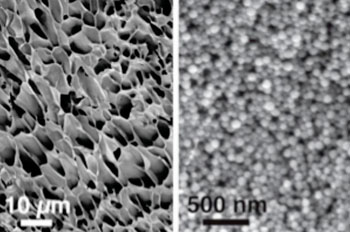Nanoparticle-Based Hydrogel Liquefies Under Pressure for Delivery by Syringe
By LabMedica International staff writers
Posted on 05 Mar 2015
A hydrogel that liquefies under pressure but reforms as a gel when the pressure is released has been recruited as a delivery system for both hydrophobic and hydrophilic anticancer agents.Posted on 05 Mar 2015
Investigators at the Massachusetts Institute of Technology (Cambridge, USA) created the hydrogel by mixing PEG-PLA (polyethylene glycol- polymerized lactic acid) nanoparticles with polymeric cellulose. Each polymer chain formed weak bonds with a number of nanoparticles, producing a loosely woven lattice of polymers and nanoparticles. As each attachment point was fairly weak, the bonds disassociated under the mechanical stress of being injected through a syringe. Once the shear forces had abated, the polymers and nanoparticles formed new attachments with different partners, returning the conglomerate to the gel form.

Image: Scanning electron microscopy images, taken at different magnifications, show the structure of new hydrogels made of nanoparticles interacting with long polymer chains. (Photo courtesy of Massachusetts Institute of Technology).
The composition of the gel allowed it to be loaded simultaneously with two different types of drugs. The PEG-PLA nanoparticles had an inner core capable of carrying small-molecule hydrophobic drugs, which include many chemotherapy agents. At the same time, the cellulose polymer, which existed in aqueous solution, could transport hydrophilic molecules such as proteins, including antibodies and growth factors.
A detailed description of the hydrogel as well as results of an in vivo experiment in which gels injected under the skin of mice survived and successfully released two drugs—one hydrophobic and one hydrophilic—over a period of several days, was published in the February 19, 2015, online edition of the journal Nature Communications.
“We are working with really simple materials,” said contributing author Dr. Mark Tibbitt, a postdoctoral researcher at the Massachusetts Institute of Technology. “They do not require any advanced chemical functionalization. Now you have a gel that can change shape when you apply stress to it, and then, importantly, it can re-heal when you relax those forces. That allows you to squeeze it through a syringe or a needle and get it into the body without surgery.”
Related Links:
Massachusetts Institute of Technology














